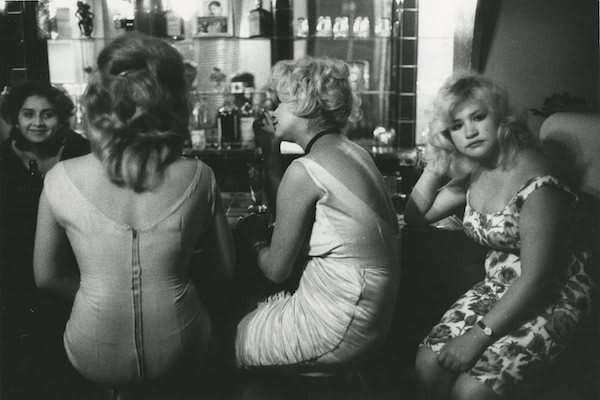-
Artworks

Sergio Larrain
Bar Los Siete Espejos (Bar of Seven Mirrors), Valparaiso, Chile, 1963Vintage gelatin silver printPaper size: 17.2 x 25.5 cmDated in pencil, various annotations in red pen and black pencil and Magnum artist copyright wet stamp versoLiterature
BIOGRAPHY
ENGLISH
Sergio Larrain (1931-2012, born in Valparaiso, Chile) grew up in Chile, but left at age eighteen to study at the University of California, Berkeley. Upon his return he began taking photographs in the streets of Santiago and Valparaiso; and the early purchase of two images by the Museum of Modern Art, New York, reassured him in his chosen profession. Impressed by Henri Cartier-Bresson's photographs, Larrain presented the photographer his work on los abandonados (street children in Santiago) during a trip to Europe. Cartier-Bresson then invited Larrain to join Magnum in 1960; around this time he also began what would become a legendary project on Valparaiso with a text by poet Pablo Neruda.
A notoriously reclusive artist, Sergio Larrain has nonetheless become a touchstone for those who have come to know and love his work, including authors Roberto Bolaño and Julio Cortázar. Larrain's experimental process yielded images that transformed the fixed nature of the medium. His images have left generations of viewers in awe of the simultaneous serenity and spontaneity that a camera can capture-when placed, that is, in the hands of an artist with such rare meditative passion. "A good image is born from a state of grace," the artist once explained.
Following a creatively fertile period in the 1950s and '60s, Larrain put away his camera and devoted himself to the solitary pursuit of spiritual mysticism, a decision that further contributed to his reputation as a romantic, a "fatal personage," in the words of Bolaño.
SPANISH
Sergio Larraín (1931-2012, nacido en Valparaíso, Chile) creció en Chile, pero se fue a los dieciocho años para estudiar en la Universidad de California, Berkeley. A su regreso comenzó a tomar fotografías en las calles de Santiago y Valparaíso; y la temprana compra de dos imágenes por el Museo de Arte Moderno de Nueva York le tranquilizó en su profesión elegida. Impresionado por las fotografías de Henri Cartier-Bresson, Larraín presentó al fotógrafo su trabajo sobre los abandonados (niños de la calle en Santiago) durante un viaje a Europa. Cartier-Bresson invitó entonces a Larrain a unirse a Magnum en 1960; por esta época también inició lo que se convertiría en un proyecto legendario sobre Valparaíso con un texto del poeta Pablo Neruda.
Sergio Larraín, artista notoriamente solitario, se ha convertido sin embargo en una piedra de toque para quienes han conocido y amado su obra, entre ellos los autores Roberto Bolaño y Julio Cortázar. El proceso experimental de Larrain produjo imágenes que transformaron la naturaleza fija del medio. Sus imágenes han dejado a generaciones de espectadores asombrados por la serenidad y espontaneidad simultáneas que una cámara puede captar cuando se coloca, es decir, en las manos de un artista con una pasión meditativa tan poco común. "Una buena imagen nace de un estado de gracia", explicó una vez el artista.
Después de un período creativo y fértil en los años 50 y 60, Larraín dejó su cámara y se dedicó a la búsqueda solitaria de la mística espiritual, una decisión que contribuyó aún más a su reputación de romántico, un "personaje fatal", en palabras de Bolaño.
